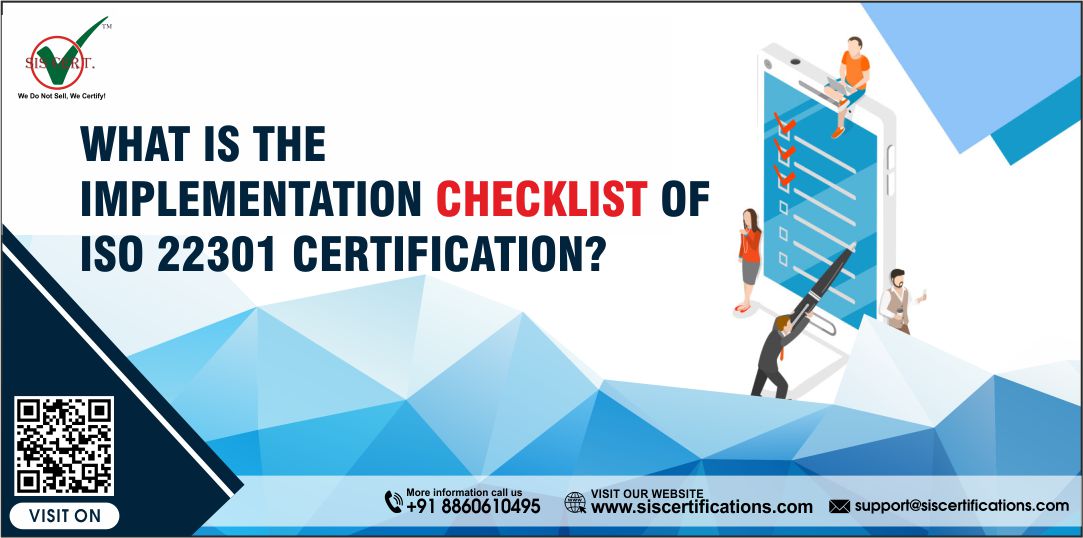COVID-19 has changed all the dimensions of doing business. It has changed all ways organizations used to follow earlier. It has made us pursue new ideas and ways to conduct day-to-day business operations. Checklist of ISO 22301 Certification a Business Continuity Management System (BCMS) offers a framework for organizations to carry out their business operations and processes without disruption
What is ISO 22301 Certification?
ISO 22301 Certification is the world’s first standard that provides a framework for Business Continuity Management System (BCMS). It establishes and manages an effective business continuity and aims to provide resilience to organizations to prevent, minimize and recover from disruptive incidents or crisis.
The Benefits of ISO 22301 Certification ⮯
The ISO 22301 certification offers the following benefits to an organization:
- Business protection is significant and safeguards the value of assets and trains an organization to manage its resources. It allows organizations to conduct operations without disruption and execute effective recovery plans when needed.
- Unifies regional, national, and international regulations in a single framework to establish an effective business Continuity Management System. An organization must comply with all the laws and regulations.
- Safeguards business investments and income. Checklist of ISO 22301 Certification helps organizations manage their assets. It allows organizations to protect their income during natural calamities and incidents and reduces losses.
- Increases the reliability and credibility of an organization. It creates a better image among customers and potential business partners and demonstrates its ability and effectiveness in responding to unprepared incidents.
- Non-conformities are identified and addressed accordingly. An organization must have a contingency plan to manage incidents of disaster or unpredictable occurrences. ISO 22301 standard follows the Plan-Do-Check-Action model to implement effective business management.
- Ensures continuous business operations and follows a risk-based approach to identify potential risks. It requires formulating strategies to mitigate them and demonstrates the organization’s effectiveness in implementing effective responses and reducing disruptions.
- Saves the life of employees as it requires conducting fire drills and implementing effective recovery plans. It demonstrates the organization’s concern for the employees’ life and responsibility to provide safe and healthy workplaces.
- Secures resilience in the supply chain to establish Business Continuity Management. An organization needs a robust and resilient supply chain to provide products and services. A Business Continuity Management System indicates an organization’s commitment and ability to produce opportunities and address risks.
ISO 22301 Certification Implementation Checklist⮯
- Gaining the support of management – An organization must win the support and confidence of all stakeholders to secure a successful implementation of ISO 22301 Certification. Employees are the human capital of any organization, and their active participation plays a significant role.
- Determining the requirements – The organization must identify the prerequisites to establish business continuity and communicate them with all stakeholders and interested parties.
- Defining scope of Business continuity – The management requires defining the policies and responsibilities for business continuity. An organization must determine the scope and objective of business continuity and review the effectiveness and efficiency of the business continuity system.
- Conducting a risk assessment – An organization requires performing a risk assessment to determine potential risks and opportunities and address them accordingly.
- Business impact analysis – It defines requirements for an organization to find out two things. That is:
- Effectiveness of the recovery plan
- Recovery time objectives are requirements for the successful recovery process.
- Business continuity plan – There are several kinds of business continuity plans. These are:
- Incident response plan
- Recovery plan
- Training and awareness – A business continuity plan prepares the business for an unexpected incident or crisis. It requires providing necessary training to employees so that they know how to save their lives during an incident. It also instructs the organization to execute mock drills and develop recovery plans.
- Documentation maintenance – It requires maintaining records and documents of all business operations and helps in assessing their business operations.
- Performing post-incident reviews – It requires conducting a post-incident review to train employees. A post-incident review allows an organization to evaluate the effectiveness of a recovery plan.
- Communication – Business continuity depends on the relationship between interested parties, regulatory bodies, authorities, owners, and stakeholders. An organization must establish an effective communication system, internal and external, to keep everyone informed.
- Performance measurement and evaluation – Performance evaluation enables the organization to understand the effectiveness and efficiency of business operations. It measures the business continuity plans and policies.
- Performing an internal audit – An organization must conduct an internal audit to identify the weak areas and shortcomings. An internal audit allows organizations to achieve the desired outcomes and eliminate factors that might cause unintended results.
- Corrective actions – After conducting an internal audit, the organization must implement corrective actions to eliminate shortcomings and mitigate factors that cause undesired outcomes.
Conclusion ✅
ISO 22301 is an internationally recognized standard for Business Continuity Management Systems (BCMS). It helps organizations to protect and reduce the occurrence of unprepared events and prepare to respond and recover from incidents disrupting business operations.
It seeks to implement, sustain and improve a management system to protect against business-related risks. It follows a risk-based method to identify and address the potential risks and formulates strategies to mitigate them. ISO 22301 certification is a generic standard, and any organization can apply for ISO 22301 certification, regardless of size, nature, and location.




